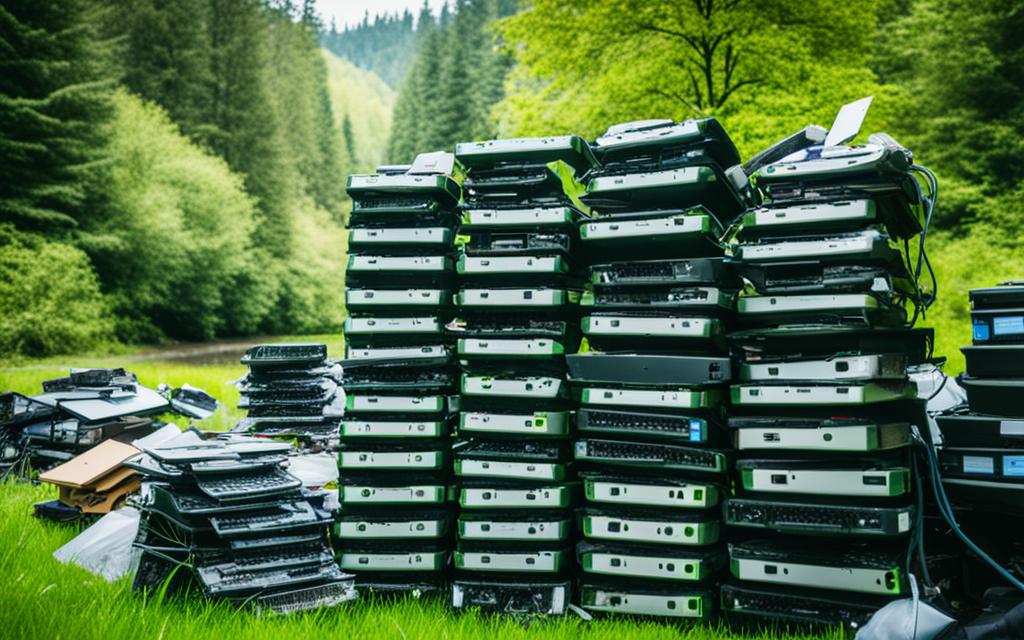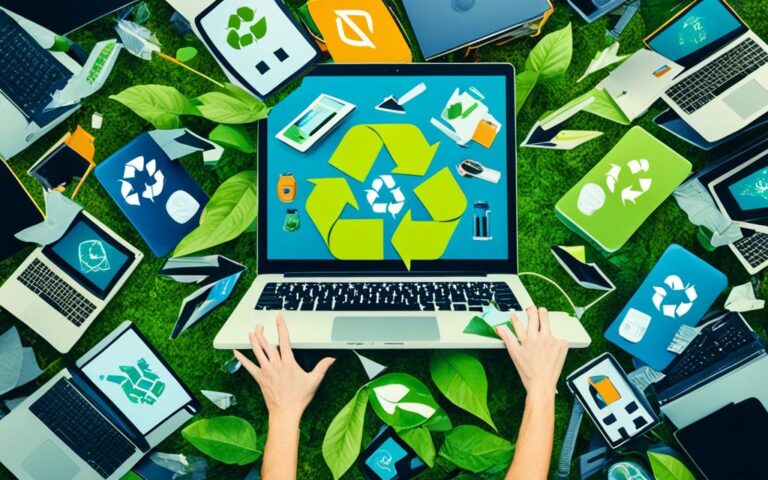The Connection Between Laptop Recycling and Green Computing
Green computing, also known as green technology or green IT, is the environmentally responsible and eco-friendly use of computers and their resources. It involves reducing the environmental impact of technology through energy efficiency and proper disposal of electronic waste. Laptop recycling plays a vital role in advancing green computing practices by minimizing waste and promoting sustainability. By recycling laptops, we can reduce the carbon footprint generated by the IT industry and contribute to a greener environment.
The Benefits of Green Computing
Green computing plays a crucial role in reducing the environmental impact of technology. By adopting energy-efficient practices and proper disposal of electronic waste, we can make a significant difference in saving resources and preserving our planet. Let’s explore some of the key benefits of green computing:
1. Energy-efficiency
One of the major advantages of green computing is its emphasis on energy efficiency. By using energy-efficient CPUs, servers, and peripherals, we can significantly reduce resource consumption. This not only saves energy but also helps to decrease carbon emissions and minimize the overall environmental impact. Energy-efficient devices contribute to a greener and more sustainable future.
2. Proper disposal of e-waste
Green computing also addresses the issue of electronic waste, known as e-waste. With the rapid advancement of technology, electronic devices become obsolete more quickly, leading to increasing amounts of e-waste. By recycling unwanted electronic devices, we can prevent hazardous substances from ending up in landfills and reduce the environmental risks associated with e-waste. Proper disposal of e-waste promotes sustainability and protects both human health and the environment.
“Green computing aims to reduce the environmental impact of technology through energy-efficiency and proper disposal of electronic waste.”
To illustrate the environmental impact of e-waste, consider the following statistics:
| No. of electronic devices discarded annually | Environmental impact |
|---|---|
| 50 million smartphones | Contains approximately 50 tons of e-waste, contributing to pollution and resource depletion |
| 20 million laptops | Results in the release of approximately 200,000 tons of CO2 emissions |
| 10 million tablets | Produces about 1,000 tons of plastic waste, contributing to landfill pollution |
3. Reducing carbon emissions
By promoting energy efficiency and reducing electronic waste, green computing has a direct impact on carbon emissions. The use of energy-efficient devices and practices helps to minimize the consumption of electricity and, consequently, the carbon footprint of the IT industry. This contributes to a healthier and more sustainable environment, combating climate change and its adverse effects.
Environmental sustainability and the preservation of our planet are at the forefront of green computing initiatives. By practicing energy-efficiency and responsible e-waste disposal, we can minimize the negative environmental impact of technology and pave the way for a more sustainable future.
The Importance of Green Computing
The use of computers contributes significantly to CO2 emissions and energy consumption. It is estimated that only about 15% of the power spent on powering computers worldwide is actually used for computing, while the rest is wasted idling. This consumed energy is a major contributor to CO2 emissions, and by saving energy through green computing practices, we can reduce carbon emissions and address climate change. Green computing plays a crucial role in achieving environmental sustainability and creating a greener future for our planet.
Initiatives and Strategies for Green Computing
Various initiatives and strategies have been launched over the years to promote green computing. These efforts aim to minimize waste, conserve energy, and reduce the environmental impact of the IT industry. Let’s explore some key initiatives and strategies:
1. Energy Star Program
The Energy Star program, launched by the U.S. Environmental Protection Agency, promotes and recognizes energy efficiency in various product categories. Energy Star-certified devices meet strict energy efficiency guidelines, helping users reduce their energy consumption and carbon footprint.
2. Power Management
Power management features, such as sleep mode and power-saving settings, have become widely adopted among electronics users. These features automatically adjust power consumption when devices are not in use, resulting in significant energy savings.
3. Equipment Recycling
Another important initiative is equipment recycling. Recycling unwanted electronic devices helps prevent hazardous substances from ending up in landfills, reduces the need for raw materials in manufacturing new products, and promotes the circular economy.
4. Virtualization
Virtualization involves running multiple virtual machines on a single physical device, maximizing resource utilization and reducing the number of physical servers required. This not only saves energy but also minimizes space requirements and lowers maintenance costs.
5. Cloud Computing
Cloud computing enables organizations to access and utilize IT resources over the internet, eliminating the need for individual physical infrastructure. Cloud services allow for scalability, efficient resource allocation, and reduced energy consumption.
6. Green Manufacturing
Green manufacturing focuses on designing and producing electronic devices with reduced environmental impact. This includes using eco-friendly materials, optimizing manufacturing processes to minimize waste, and implementing energy-efficient production techniques.
By implementing these initiatives and strategies, we can pave the way for a more sustainable IT industry and contribute to a greener future.
Green Computing and the IT Industry
The IT industry is taking significant steps towards green computing. Intel, for example, has committed to achieving net positive water use, 100% green power, and zero waste to landfills across its global manufacturing operations by 2030. In addition, Intel emphasizes the need for collaboration with industries, governments, and communities to address climate change and enhance corporate responsibility. The IT sector as a whole is investing in green computing modules and devices, reducing the use of hazardous materials, and expediting the recycling process to promote environmental sustainability.
“Our vision is to deliver leading-edge technology with a net positive impact on the environment. We believe in the power of technology to transform industries and address global challenges while minimizing our impact on the planet.” – Intel spokesperson
The Intel’s 2030 Strategy
Intel’s 2030 strategy encompasses various sustainability goals aimed at reducing the environmental footprint of its operations. These goals include:
- Net positive water use: Intel aims to restore more water than it consumes, focusing on water conservation and responsible usage.
- Green power: The company is committed to utilizing 100% green power across its operations, emphasizing renewable energy sources.
- Zero waste: Intel aims to eliminate waste to landfills, implementing efficient waste management practices and promoting circular economy principles.
- Corporate responsibility: Intel emphasizes the importance of social and environmental responsibility, collaborating with stakeholders to drive positive change.
By embracing these sustainability initiatives, Intel and other companies in the IT industry are paving the way for a more environmentally conscious future. Through their commitment to green computing and corporate responsibility, they are not only reducing their own environmental impact but also inspiring others to follow suit.
This image showcases the determination of Intel to achieve sustainability goals and contribute to a greener world.
Conclusion
Green computing and laptop recycling are crucial for sustainable practices and preserving the environment. By embracing green computing and appropriately recycling electronic devices, we can significantly reduce energy consumption, carbon emissions, and the overall environmental impact of the IT industry. It is imperative for individuals, businesses, and governments to proactively adopt green computing practices and prioritize laptop recycling to create a greener and more sustainable future for future generations.
By implementing energy-efficient technologies and disposing of electronic waste responsibly, we can contribute to the reduction of greenhouse gas emissions and combat climate change. Green computing and laptop recycling are not only environmentally beneficial but also economically advantageous, as they reduce energy costs and promote resource conservation.
To achieve sustainable practices, we must collaborate with industries, governments, and communities to foster a culture of environmental responsibility. Together, we can make a substantial difference in protecting our planet and fostering a more sustainable IT industry. Let us all embrace green computing and prioritize laptop recycling to create a better and more sustainable future for our planet.
FAQ
What is green computing?
Green computing, also known as green technology or green IT, is the environmentally responsible and eco-friendly use of computers and their resources. It involves reducing the environmental impact of technology through energy efficiency and proper disposal of electronic waste.
How does laptop recycling contribute to green computing?
Laptop recycling plays a vital role in advancing green computing practices by minimizing waste and promoting sustainability. By recycling laptops, we can reduce the carbon footprint generated by the IT industry and contribute to a greener environment.
What are the benefits of green computing?
One of the major benefits of green computing is energy efficiency. By using energy-efficient CPUs, servers, and peripherals, we can reduce resource consumption, save energy, and reduce carbon emissions and the overall environmental impact. Another important aspect is the proper disposal of electronic waste or e-waste, which prevents hazardous substances from ending up in landfills and minimizes environmental risks.
Why is green computing important?
Green computing aims to reduce the environmental impact of technology. It helps address issues such as CO2 emissions, energy consumption, and climate change. By adopting green computing practices, we can save energy, reduce carbon emissions, and contribute to environmental sustainability.
What initiatives and strategies are used to promote green computing?
Various initiatives and strategies have been launched to promote green computing. These include the Energy Star program, power management features like sleep mode, equipment recycling, reduction of paper usage, virtualization, cloud computing, power management, and green manufacturing. These efforts aim to minimize waste, conserve energy, and reduce the environmental impact of the IT industry.
How is the IT industry embracing green computing?
The IT industry, including companies like Intel, is taking significant steps towards green computing. For example, Intel has committed to achieving net positive water use, 100% green power, and zero waste to landfills across its global manufacturing operations by 2030. The sector as a whole is investing in green computing modules, reducing the use of hazardous materials, and expediting the recycling process to promote environmental sustainability.















